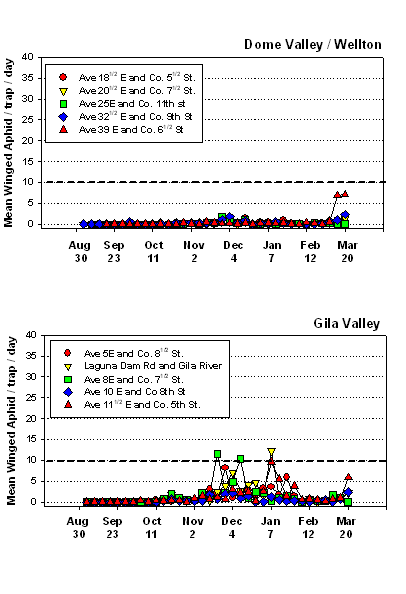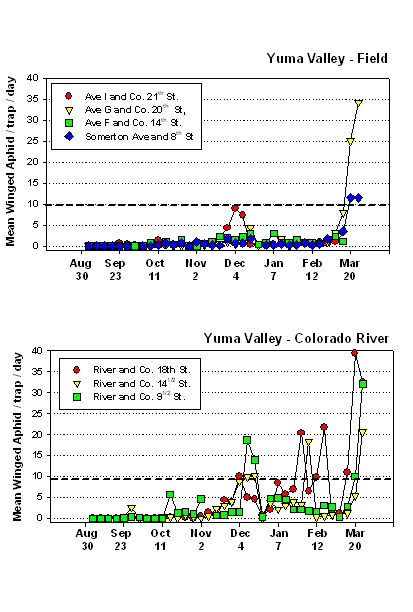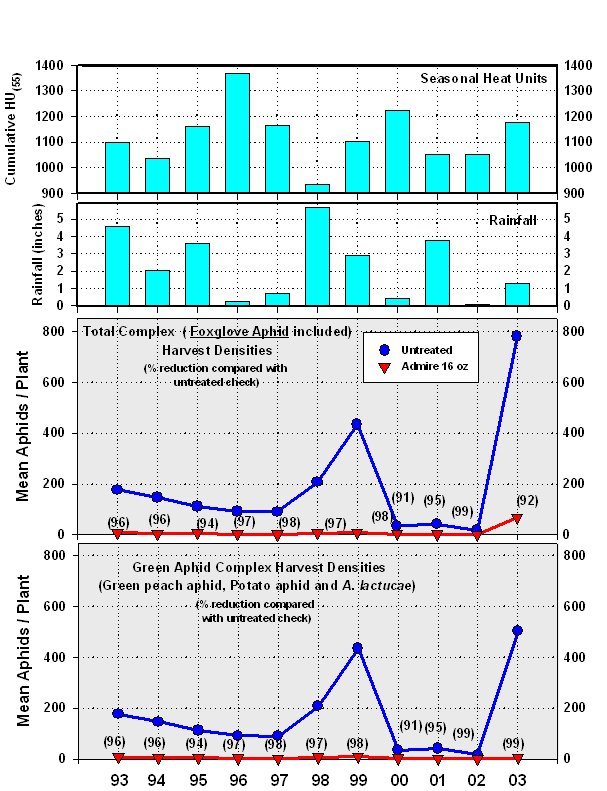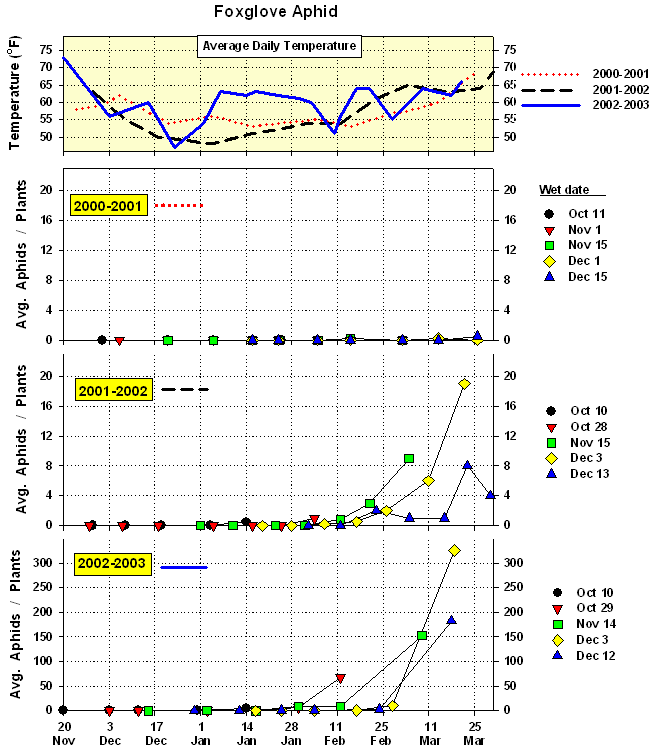Foxglove Aphid: Is it an Emerging Pest in the Desert?
John Palumbo, Yuma Agricultural Center
Note:
Winged foxglove aphids were found on head lettuce in the Yuma Valley
near Co. 15th and the west main canal this past week. It's
probably not a coincidence that the earliest reports of foxglove aphids
were found in this same area last November. Although, no colonization
by foxglove or any aphid species has been reported in lettuce yet, these
findings should serve as an indication to PCA's and growers that foxglove
aphids could potentially be present in large numbers again this winter
and spring. In the report below, I discuss our experiences with foxglove
aphids and the environmental factors which may influence their population
growth and abundance on desert lettuce.
Introduction
Aphids are one of the most important insect problems in head lettuce grown in Arizona. A new aphid species, the foxglove aphid, Aulacorthum solani, was found infesting commercial lettuce fields in the Yuma area for the first time this past growing season. Foxglove aphids are thought to occur throughout the U.S and Canada, but its effect is generally greatest in the eastern regions of the continent. It is also found worldwide, but is probably of European origin. Surprisingly, it has been known to occur in California since at least 1940, and along with the lettuce aphid, Nosanovia ribis-nigri, has caused problems for lettuce growers in Salinas area for the past several years. Although, the lettuce aphid is the more important of the two in Salinas, studies last spring suggest that foxglove aphid may be a more important pest in the desert.
The foxglove aphid (
pictures) appears to be similar to the lettuce aphid in that the alates
(winged forms) are difficult to differentiate, both aphids have short
life cycles that allow populations to build up rapidly, and both tend
to prefer to colonize the youngest tissue near the terminal growing point
of the plant. Apterae (wingless forms) foxglove aphid are also often confused
with the green peach aphid, Myzus persicae. Both aphids are usually
yellow-green to all green but the green peach aphid may also be somewhat
pink or red, as is the lettuce aphid. The foxglove aphid is slightly larger
(maximum length is 3.0 mm) than the green peach aphid (max. length is
2.3 mm). One way to distinguish these two aphids is by the dark joints
found on legs and antennae of the foxglove aphid, and the dark tips of
the cornicles. The green peach aphid also has pale-colored legs and antennae
but without dark joints. Foxglove aphids are also unique in that they
have a bright green or dark colored spot at the base of each cornicle.
Alates have a pattern of transverse dark bars on the dorsal abdomen.
The foxglove aphid was not previously thought to occur in Arizona. It is principally considered a serious pest of potatoes and is also found on ornamental and greenhouse plants. It is considered an occasional pest of lettuce and leafy vegetables grown in Canada. Unlike the lettuce aphid which was first found in Yuma five years ago, the foxglove aphid is known to colonize a much broader range of plant hosts, including a wide variety of weeds, ornamentals and crops. This large availability of hosts and apparent adaptation to our winter and spring growing conditions suggests that foxglove aphids might present growers with some new challenges.
There is much uncertainty surrounding this new species, and its ability to thrive within our desert growing conditions. We are not sure how or when the foxglove aphid moved into the Yuma area, but it seems likely that it may have arrived via transplants or harvest equipment, much like we suspect with the lettuce aphid. Because this species is polyphagus and utilizes a number of known host plants grown in the desert, we are concerned that foxglove aphids may become an established pest on our winter/spring crops. In terms of management, control with foliar aphicides appears to be more difficult because the aphids preference for the protected terminal growth. We have had the opportunity to conduct a considerable amount of field research over the past two growing seasons to learn more about this pest. Because of the importance of the foxglove as a contaminant of lettuce and other leafy vegetables, we designed several studies to its examine its population growth, distribution, and damage potential.
Research Methods
The incidence and distribution of foxglove aphids in the Yuma growing area was measured in several different ways for this report. First, information describing seasonal aphid activity on an area-wide basis was generated from a network of yellow sticky traps that were monitored weekly from late August through March. We have been monitoring aphid activity since 1998 and have specifically been identifying foxglove and lettuce aphid species. Yellow sticky traps were located at several sites throughout Yuma County's vegetable growing areas. Three- five trapping stations were situated in the Yuma Valley, Gila Valley and Dome Valley/Roll areas for a total of 17 trap locations. In addition, in 2002-2003 we situated traps along the Colorado River in the Yuma Valley. At least one location in each growing area was situated near an AZMET weather station. The approximate location of traps in each valley was selected with the assistance of local PCAs. At each site, a single yellow sticky traps was placed in an open area adjacent to or near a field. Traps were collected 1-2 times per week and replaced. Sticky traps were taken to the laboratory where all aphids were counted and recorded. Only 6 aphid species were consistently identified (foxglove, lettuce, green peach, cabbage, potato, and cowpea aphids). Data from trap captures was converted to the mean number of winged aphids / trap/ day and presented in a graphic format.
Surveys of commercial lettuce fields were conducted in the 2002-2003 growing season to document the incidence of foxglove colonization. Working with cooperating growers, surveys were conducted from 20 Dec through 24 Feb in 1-7 fields per week. Both head lettuce and romaine were sampled and none of the fields surveyed had been treated with imidacloprid (Admire). Fields ranged from 9-22 acres in size and were located in the north Yuma Valley, south Yuma Valley, and Gila and Dome Valleys. On each survey date, at least 20 lettuce plants in a single location in each field were randomly selected and sampled for the presence of foxglove aphids. Each plant was sampled by visually examining all plant foliage and estimating the number of alate and apterous aphids present. The number of infested fields, percentage of infested plants and average number of aphids per infested plant were summarized for all fields surveyed on each sample date.
To examine the population dynamics and damage potential of foxgloves experimental field plots were established in head lettuce at the University of Arizona, Yuma Agricultural Center as part of an on-going study. Beginning in mid-October 1999, ¼ acre plots of head lettuce were planted on 2-3 week intervals. Table 4 provides the planting date and lettuce variety for each planting. On each planting date (wet date) lettuce was direct seeded into double row beds on 42 inch centers. Each planting was subdivided into 4 plots consisted of 4 beds, 150 feet long. Plots were arranged in a randomized complete block design with four replications. No insecticide applications were made during the study. Aphid populations were assessed by estimating the number of aphids/plant by taking whole plant destructive samples. On each sampling date, 10 plants were randomly selected from each plot and placed individually into large 4-gal tubs. Each plant was sampled by visually examining all plant foliage and counting the number of alate and apterous aphids present. At harvest, infestation levels of apterous aphids were estimated by randomly selecting 10 plants within each replicate, visually counting the number of aphids on frame/wrapper leaves and heads, and separately recording aphid numbers for each location. Weather data observed from the AZMET station at the Yuma Ag Center was used to examine the influence of temperature and rainfall on foxglove abundance and population growth.
Research Results and Significance
Light populations of foxglove aphids were first found colonizing untreated head lettuce in small experimental plots at the Yuma Agricultural Center (YAC) in the spring of 2001. Initially, the aphids were thought to be potato aphids, but were later identified as A. solani. This was further verified in the spring 2002 when aphids found on untreated experimental lettuce plots at YAC were identified as foxglove aphids. However, no foxglove aphid has been reported from PCAs or growers that season. Furthermore, winged alate aphids had not been found in the Yuma area for the past several years . In general, aphid flight activity as measured by sticky trap captures varies considerably throughout the region. The most consistent bimodal patterns are found in the Yuma Valley. Most of the aphids captured on these traps consisted of a number of unidentified aphids, as well as those we identified (cowpea aphid, cabbage aphid and green peach aphid). In 2002,/2003 aphid numbers were relatively low in the Gila and Dome Valley growing areas and no foxglove alates were found on traps (Figure 1). However, aphid numbers were more abundant in the Yuma Valley, particularly near the Colorado River, where traps captures during the spring were much higher than other areas (Figure 1). Foxglove alates were found on traps in the Yuma Valley on 10 Dec at Ave I and 21st, and then again on 7 Jan at Ave F and Co. 14th. Foxglove aphids were found fairly regularly on traps placed on the Colorado river beginning on Jan 7. This occurrence coincides with unseasonable warm weather we experienced in January of 2003.
The first documented incidence of foxglove aphid colonies in commercial lettuce occurred on Nov 12, 2002 in the Yuma Valley (Ave. D and Co. 12th st.). A PCA discovered a small number of apterous foxglove aphids colonizing pre-harvest stage head lettuce. The field was located adjacent to a residential area with Pecans trees. The field had not been treated with Admire. Following treatment with a foliar insecticide, the aphids were not found again in that field. On Nov 20, a small number of apterous foxglove aphids were found on wrapper leaves of head lettuce that was being harvested in the Yuma Valley (Co. 13 and Ave F). This field was located within a ½ mile of a citrus orchard and had not been treated with Admire. Then on Nov 24, a single alate foxglove aphid was found on untreated head lettuce on Co. 15th near the west main canal and a pecan orchard. Similarly, a few alate foxglove aphids were found on head lettuce on Co. 14th and Somerton Ave on Nov 27th, again on untreated lettuce. We did not receive further reports from PCAs until January when foxglove aphids infestations were becoming more common throughout the Yuma Valley. Results of our field surveys of untreated lettuce showed that foxglove aphids were sporadic in the Yuma Valley throughout December, but became more consistent during January and February (Table 1). Surprisingly, foxglove aphids were not reported from PCAs in either the Gila or Dome Valley growing areas, nor were they found in our commercial field surveys.
In most cases, the commercial fields infested with foxglove aphids were near the Colorado River and/or adjacent to citrus orchards and residential areas. Unlike the lettuce aphid which was first found in Yuma five years ago, the foxglove aphid is known to colonize a much broader range of host plants (Table 2). These include a wide variety of weeds (i.e., Shepard's purse, ground cherry, pigweed), ornamentals (i.e., geraniums, gladiolas, verbena) and crops (i.e., cucurbits, beans, canola, spinach, citrus, safflower, tomatoes) that are commonly found throughout the growing region in cultivated fields, residential areas, or along the Colorado and Gila rivers. This large availability of hosts, available year round in some cases, could allow the foxglove aphid to become an established pest of lettuce and other leafy vegetables. However, why foxglove aphid was not found in the Gila and Dome Valley areas, given their similarity in host crops, is unclear.
Aphid populations in general were higher in 2003 than in the previous 10 years, based on a summary of small plot efficacy trials planted during mid-November (Figure 2). There does not appear to be a strong correlation with seasonal heat unit accumulation or rainfall. The peak in aphid numbers seen this past year was a result of a greater abundance of the green aphid complex (green peach aphid, potato aphid and Acyrthosiphon lactucae, a common aphid species found in Yuma) as well as a the emergence of the foxglove aphid (Table 3). Numbers of A. lactucae were very high this year, relative to previous years, peaking in mid-November and December wet dates. In contrast, green peach and potato aphid populations have been very light the past few years. Lettuce aphids also reached peak numbers in 2003. Foxglove aphids numbers on untreated lettuce were also much higher in 2003 than in 2002 (Figure3), peaking during March (in the Dec 3 planting ) in both years.
Figure 4 shows a comparison among the aphid species in individual lettuce plantings last season. This data shows that the foxglove aphid appears to have a much broader range of activity in desert lettuce than the other species. Traditionally we have concluded that lettuce crops are susceptible to economic infestations from aphids when planted beginning in mid-November. Foxglove aphids last year were the dominant species in October plantings, particularly in the late October when populations reached levels exceeding 60 aphids/plant at harvest. Although the A. lactucae was the dominant species in the November and December plantings, foxglove aphid populations also reached high numbers, reaching densities greater than 300 aphids per plant during March.
Based on our studies over the past several years we have also made some other interesting observation concerning aphids in lettuce. First, the high aphid densities occurring last season may have been influenced by both temperature and rainfall (Table 3). Temperatures were similar for each planting, averaging 58-59 F. Unlike the previous three years, the average max and min temperatures in 2002-2003 were fairly uniform for each planting, presumably causing little disruption in aphid population growth. Another interesting observation was the consistent amount of rainfall that was received during the last 4 planting windows, averaging well over an inch of rain. We have felt for years that rainfall benefited aphid abundance in desert lettuce production. Similarly the green aphid complex reached higher number in 2000-2001 under considerable rainfall. This data further support our contention that growers may be at more risk from aphid infestation during mild, wet winter conditions.
Another observation from last year concerned the distribution of foxglove aphids within lettuce plants. Table 3 shows the numbers of aphids on both heads and frame leaves measured at harvest. This data clearly shows that aphids caused economic damage (head contamination) to head lettuce in the November and December plantings in 2002-2003. However, more aphids were found on the frame and wrapper leaves (53 % in 2002, 68 % in 2003) than were found in the head at harvest (47 % in 2002, 32 % in 2003). This is quite different from the other aphid complexes. Lettuce aphids are consistently found in greater numbers in the head (>90%) and populations of green aphids are less commonly found in heads (<25%). Foxglove aphids were found to colonize plants differently as well throughout the season. It has been my experience that this aphid has a tendency to disperse widely among leaves, often found near the butt of plants, rather than forming close-knit colonies as green peach aphid and lettuce aphids do.
In conclusion, it now appears that foxglove aphids have become an established pest of lettuce in the desert southwest. We have seen a progressive buildup each year of their number and currently appear to be centered in the Yuma Valley. The large availability of hosts and apparent adaptation to our winter and spring growing conditions suggests that foxglove aphids might continue to be present in our region. Although they have not been found in the Gila and Dome Valleys yet, the fact that many of the same host are available for colonization suggest that they will eventually show up in these areas. Management of foxglove aphids has not been well studied, largely because it has only recently been found in commercial lettuce. Insecticide efficacy trials from last season have shown that several registered insecticides provided adequate control of these aphids (see articles below). Application of Admire, which has been the standard for aphid control in the desert, is strongly recommended for foxglove aphid control in spring lettuce. Furthermore, given the discovery of winged foxglove aphids, and the projections by the National Weather Service (http://www.cpc.ncep.noaa.gov) that temperatures this winter will likely be warmer than the long-term averages, growers should consider applying Admire at higher rates (19-20 oz/acre) for late November and December plantings.
For Additional Information on Foxglove Aphid Biology and Management visit the following articles at the Arizona Crop Information Site: http://cals.arizona.edu/crops/
Insect Management For Desert Lettuce Production (9/03 AZ Lettuce Research Council report), PDF file, 1.67MB
Foxglove Aphids in Lettuce: Control with Reduced-Risk and Conventional Insecticides (2003), PDF file, 44KB
The Emergence of the Foxglove Aphid, Aulacorthum solani, as an Economic Pest of Lettuce in the Desert Southwest (2003), PDF file, 400KB
Figure 1. Seasonal aphid flight activity (all aphid species) as measured by yellow sticky traps during, 2002-2003
Table 2. List of crop, weed, and ornamental plants that Foxglove Aphid has reportedly been observed feeding on in California in 1945-1946. (Essig 1947, Hilgardia 17: 597-616).
| Weeds | Ornamentals | Crops |
|
Ragweed |
Hollyhock |
Celery Brassicas Squash Pumpkin Strawberry Soybean Tomato Mint Beans Peas Potato Eggplant Citrus |
Figure 2. Average aphid abundance on Admire-treated and untreated head lettuce at harvest from 1993-2003. Data was summarized from 2-3 efficacy trials conducted at comparable times in each year where lettuce plots were planted during mid-November.
Figure 3. Average Foxglove Aphid densities on untreated head lettuce planted at intervals during the growing season, Yuma Agricultural Center, 1999-2003.
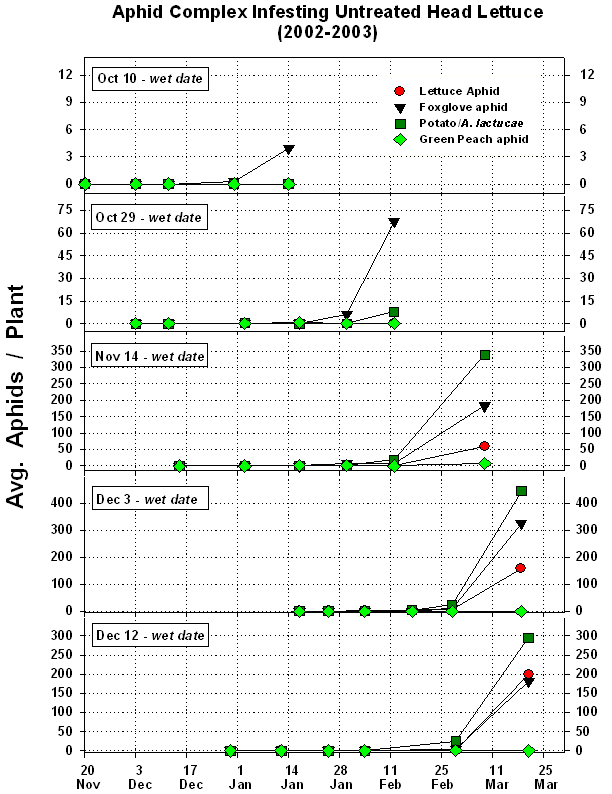
Figure 4. Relative comparison of aphid species infesting untreated
head lettuce in plots planted at various intervals during the growing
season, Yuma Agricultural Center, 2002-2003.
Table 3. Population abundance of apterous (non-winged) aphids colonizing untreated lettuce and associated weather conditions, Yuma Agricultural Center, 1999-2003.
| Mean Apterous
Aphids / Plant at Harvest |
|||||||||||||||
| Temperature (ºF) |
Green
Aphid Complex |
Lettuce
Aphid |
Foxglove
Aphid |
||||||||||||
| Growing Season |
Planting date |
Harvest date |
Lettuce Variety |
Max | Min | Avg | Rain (in.) |
Head | Frame | Head | Frame | Head | Frame | ||
| 1999- 2000 |
11-Oct | 24-Jan | Grizzley | 81 | 48 | 64 | 0 | 0 | 0 | 0 | 0 | 0 | 0 | ||
| 1-Nov | 20-Feb | Wolverine | 75 | 45 | 58 | 0.1 | 0 | 0 | 0 | 0 | 0 | 0 | |||
| 15-Nov | 1-Mar | Del Rio | 75 | 45 | 59 | 0.1 | 1.3 | 0.6 | 12.3 | 0 | 0 | 0 | |||
| 1-Dec | 23-Mar | Jackel | 73 | 44 | 60 | 0.3 | 0.3 | 0.3 | 8.2 | 0.5 | 0 | 0 | |||
| 15-Dec | 23-Mar | Diamond | 74 | 45 | 60 | 0.3 | 0.2 | 0.1 | 42.9 | 0.6 | 0 | 0 | |||
|
|
|||||||||||||||
| 2000- 2001 |
11-Oct | 25-Jan | Grizzley | 74 | 50 | 61 | 1.2 | 2 | 14.4 | 0 | 0 | 0 | 0 | ||
| 1-Nov | 2-Mar | Wolverine | 70 | 45 | 57 | 1.16 | 15.2 | 38.5 | 5.1 | 0 | 0 | 0 | |||
| 15-Nov | 3-Mar | Del Rio | 70 | 44 | 56 | 1.12 | 8.5 | 42.6 | 6.5 | 0.9 | 0 | 0 | |||
| 1-Dec | 26-Mar | Jackel | 72 | 46 | 58 | 2.9 | 2.6 | 12.9 | 9.6 | 0.4 | 0 | 0 | |||
| 15-Dec | 26-Mar | Diamond | 73 | 47 | 59 | 2.9 | 0.3 | 3.0 | 8.2 | 0.6 | 0 | 0 | |||
|
|
|||||||||||||||
| 2001- 2002 |
10-Oct | 14-Jan | Wolverine | 78 | 49 | 63 | 0.1 | 0 | 0 | 0 | 0 | 0 | 0 | ||
| 28-Oct | 4-Feb | Grizzley | 72 | 44 | 58 | 0 | 0 | 2.3 | 0 | 0 | 0.3 | 0 | |||
| 15-Nov | 5-Mar | Wolverine | 74 | 44 | 58 | 0 | 0.5 | 7.1 | 0 | 0 | 0 | 0.1 | |||
| 3-Dec | 22-Mar | Diamond | 72 | 41 | 57 | 0 | 3.6 | 7.9 | 1.1 | 0.1 | 11.7 | 2.9 | |||
| 13-Dec | 6-Apr | Diamond | 73 | 42 | 57 | 0 | 1.0 | 1.5 | 6.3 | 0.4 | 1.4 | 6.3 | |||
|
|
|||||||||||||||
| 2002- 2003 |
10-Oct | 14-Jan | Wolverine | 77 | 47 | 59 | 0.03 | 0.4 | 3.5 | 0 | 0 | 0.5 | 3.4 | ||
| 29-Oct | 12-Feb | Grizzley | 74 | 45 | 59 | 1.27 | 1.1 | 6.9 | 0 | 0 | 2.4 | 48.1 | |||
| 14-Nov | 9-Mar | Bubba | 73 | 45 | 59 | 1.27 | 96.6 | 244.6 | 44.7 | 16.4 | 33.9 | 120.9 | |||
| 3-Dec | 18-Mar | Diamond | 73 | 44 | 58 | 1.23 | 105.5 | 345.6 | 145.7 | 21.4 | 125.9 | 201.3 | |||
| 12-Dec | 18-Mar | Diamond | 74 | 45 | 59 | 1.23 | 126.2 | 170.9 | 182.2 | 18.9 | 81.8 | 101.0 | |||
Issued in furtherance of Cooperative Extension work, acts of May 8 and June 30, 1914, in cooperation with the U.S. Department of Agriculture, James A. Christenson, Director Cooperative Extension, College of Agriculture and Life Sciences, The University of Arizona.
The University of Arizona is an equal opportunity, affirmative action institution. The University does not discriminate on the basis of race, color, religion, sex, national origin, age, disability, veteran status, or sexual orientation in its programs and activities.
Any products, services, or organizations that are
mentioned, shown, or indirectly implied in this web document do not imply
endorsement by The University of Arizona.
Information provided by:
John C. Palumbo, jpalumbo@ag.arizona.edu Research Scientist (Entomology)
University of Arizona, Tucson, Arizona.
Material written November 2003.
For more Arizona Production Ag Information:
Home | Cotton | Veggies| Forages | Grains | Citrus | Crop x Crop | Insects | Diseases| Weeds | Pesticides | News | Weather | Research | Photos | Contacts | General Info. | Site Map
document located at: http://cals.arizona.edu/crops/counties/yuma/farmnotes/fn1103foxglove.html
Copyright © 2001 University of Arizona,
College of Agriculture and Life Sciences
Webmaster: Al Fournier (fournier@ag.arizona.edu)
